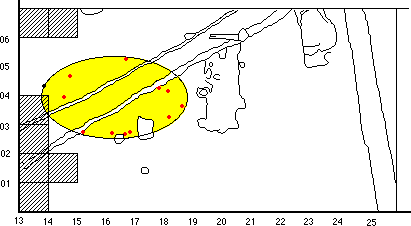
Figure 12: tools used for adzing/chopping wood:Three Ways Wharf (Key: shaded areas are unexcavated; numbers refer to metre grid squares; North is vertical to drawing)
The final stage is the discard of the material seen in knapping concentrations and clearance of areas with accompanying 'dump' areas. Curation of tools would be included at this stage in that the removal of material from the site, for use elsewhere, constitutes a form of discard.
By incorporating use-wear analysis into the chaîne opératoire, activity areas can be located from the discard of used tools, These activity areas can be used to interpret the use of space on the site which can indicate such things as social differentiation within the group. For example, the location of specific activity areas is a prerequisite for the assignment of gender roles. With undisturbed sites such activity areas can be isolated. The early Mesolithic site of Three Ways Wharf in England has a concentration of tools used for adzing/chopping wood (Fig. 12), and can only be an activity area as the pieces used for adzing/chopping wood are of various types consisting of: 1 broken axe, 2 axe/adze re-sharpening flakes, 8 flake end scrapers and 1 blade end scraper.

Figure 12: tools used for adzing/chopping wood:Three Ways Wharf (Key: shaded areas are unexcavated; numbers refer to metre grid squares; North is vertical to drawing)
Other tools of these types are distributed throughout the site and either have other functions or are unused, so that the concentration is only related to the activity of adzing and chopping wood. The adzing/chopping wood concentration is clearly separate when seen in contrast to the distribution of all used pieces from the site (Fig. 13 and see Lewis, in press).
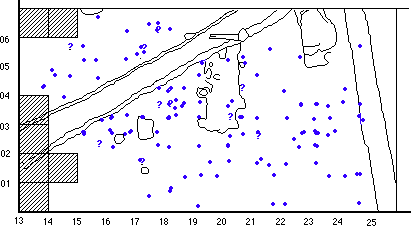
Figure 13: all used tools: Three Ways Wharf (Key: shaded areas are unexcavated; numbers refer to metre grid squares; North is vertical to drawing).
The spatial distribution of material at Kvernepollen shows clear concentrations of knapping debris with a separation between the quartzite (Fig. 14) and flint (Fig. 15), possibly representing separate knapping episodes.
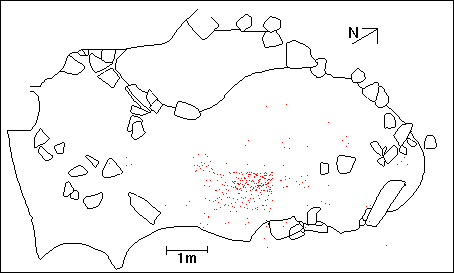
Figure 14: Kvernepollen-distribution of quartzite

Figure 15: Kvernepollen-distribution of flint
These concentrations imply that no clearance has taken place. The Farsund site has no such concentrations (Fig. 16), which could be due either to post-depositional movement or by being spread about by prehistoric activity, which would imply longer occupation than the 'undisturbed' concentrations at Kvernepollen.
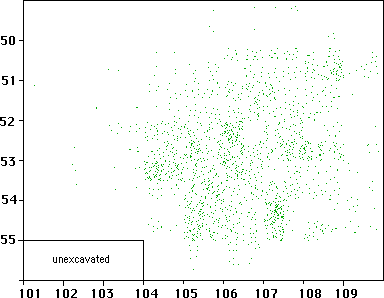
Figure 16: Farsund distribution of all lithics (Key: numbers refer to metre grid squares; North is vertical to the drawing; there were no features)
The most striking aspect of the distribution of the used pieces at Kvernepollen is that the majority of the projectile points are outside the main concentration, some being several metres away (Fig. 17).
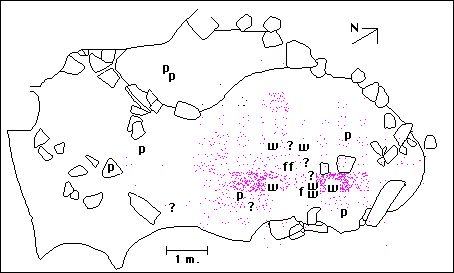
Uses of stone tools: p = proj. point ? = unidentified material w = wood f = fish
Figure 17: Kvernepollen-distribution of used pieces
The 'discarded' nature of the projectile point distribution, with the absence of butchery, suggests re-tooling. That is, replacement of projectile points and the repair and/or manufacture of arrow shafts. The presence of considerable flint knapping perhaps represents the manufacture of new projectile points in flint that were then taken away as new arrows from the site. This would partially explain the amount of knapping and the lack of used pieces. The remaining used pieces are near the centre of the concentration adjacent to the hearth and probably constitute a single activity area.
At Farsund there is no significant difference between the distribution of the used pieces and the distribution of all lithics (Fig. 18).

Uses of stone tools: p = proj. point ? = unidentified material w = wood f = fish a = antler h=hide m=meat b=bone
Figure 18: Farsund-distribution of all lithics and used pieces (Key: numbers refer to metre grid squares; North is vertical to the drawing; there were no features)
©
Internet Archaeology
Last updated: Thu Mar 20 1997